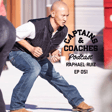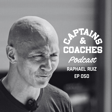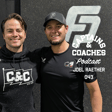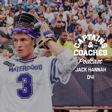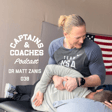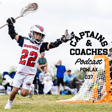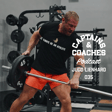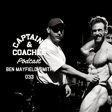00:00:00
Speaker
people are going to come up short, frustrated, hurt more. And i think plateaus are a myth, but then that's when people start talking about plateaus. And, and I think that's, and building their own barriers. I can't, yeah I've never been able to, I'm not.
00:00:16
Speaker
like And I don't, I don't fault, I don't fault them for that because the, the, the hunting for infinite scaling options is not glamorous work. But it's so in my opinion, it's the most important thing because it keeps high-performing individuals that want to make progress making progress forever.
Introduction to Podcast and Guest
00:00:34
Speaker
Welcome to the Captains and Coaches podcast. We explore the art and science of leadership through the lens of athletics and beyond. I'm your host, Tex McQuilkin, and today we're exploring the world of intentional movement with Greg Walsh, owner of Wolf Brigade in Rochester, New York.
00:00:49
Speaker
Greg and I have known each other for a long time in the coaching space and I was fortunate to catch his eye-opening movement practical at this year's and NSCA Coaches Conference in New Orleans.
Greg Walsh's Journey and Philosophy
00:00:59
Speaker
With over two decades of experience spanning with from a CrossFit, kettlebell training, martial arts, and his signature odd lifts, Greg brings us a truly unique perspective to strength and movement development.
00:01:11
Speaker
What separates Greg isn't just his impressive background training athletes, law enforcement, and military personnel, It's his remarkable ability to transform complex movement concepts into accessible wisdom that challenges both body and mind.
00:01:26
Speaker
Join us for our conversation about movement mastery, training philosophy, and the journey of growth, both as a coach and a leader. With that, let's hand it off to Greg, who helped us raise the game. Ready, ready, and
00:01:43
Speaker
You presented yesterday at the NSEA Coaches Conference in New Orleans. And saw you on there and I'm like, all right, I'm flying in early Wednesday because I want to participate. I love practicals.
00:01:55
Speaker
I love finding weaknesses in my own movement, blind spots. And you're one of the best in the business for pointing these out. Efficiency, coaching, communication. And you had a pretty active crowd yesterday. That's a lot for a practical.
00:02:07
Speaker
Yeah, it was. And thanks. Thanks for thanks for showing up. Thanks for helping. we had ah We had a great group. It wasn't the largest group, but that doesn't ever matter. The interactivity is what is what made it. We had seven, eight, nine people.
00:02:20
Speaker
Everyone moves different, so it teaches the rest of the group everything they need to know because they're watching so many bodies move through the same stuff in such a short period of time.
Transition from BMX to Strength Training
00:02:29
Speaker
It's it's it's it's a really, really effective way to diagnose and and and improve movement.
00:02:35
Speaker
Yeah, and you've been in the coaching business a long time. Wolf per grade, you've gone from California to New York yeah and everywhere in between, teaching, coaching. So speak to us of this origin. it It was focused on getting people better at moving. Did it start with sport and your connection to, i don't know what you call it what do it, street sports, BMX, biking, what do you call Action sports is what I started calling it. you know We just called it BMX riding and skateboarding. Action sports was like a...
00:03:01
Speaker
like an X Games iteration. You know, like once once things started getting popular and on TV, they had to give it a had to give it a buzzword and it was action sports. but I'm not mad at it. No, I know. I like it. It's an action sport.
00:03:12
Speaker
Yeah. People throwing themselves downstairs is is an action. is action So um where did action sport then get to training? Because I don't know if it's connected. Well, for me, it was it was BMX riding since I was 11, martial arts since I was 22, and then...
Injuries and the Path to Strength and Conditioning
00:03:29
Speaker
and then the combination of those things, both the physical attributes that they built in me, but then the damage that they did to me are what showed me that strength and conditioning had to be next.
00:03:40
Speaker
Um, with, with martial arts, I, so I started in more traditional martial arts, um, realized that wasn't really my cup of tea. And then once, once I got to California, I had trained Kenpo karate for a while and enjoyed that a lot. and And my gym was great. But then I found 2002, found my gym,
00:03:57
Speaker
um And that's where we had our early days CrossFit. That's where we had Muay Thai and submission wrestling and and all that kind of stuff. And what that started teaching me is is that there were an enormous amount of holes in the boat from taking karate and riding BMX.
00:04:14
Speaker
um most specifically strength, power, endurance, because there wasn't a lot of demand for that stuff. With BMX at that time, I was hyper-adapted to the point where it was very, very hard, but it wasn't tiring.
00:04:28
Speaker
And you know karate, of course, is very hard and and an amazing martial art. It wasn't eliciting what I wanted it to elicit. i wanted i I guess what I was looking for and didn't know it was combat sports.
00:04:40
Speaker
And I'd watched the UFC since the early ones. We so used to sneak out and go to my cousin's house and sneak the pay-per-views in the basement and all this kind of stuff. So that was always what I was looking at as far as my my training goals.
00:04:56
Speaker
And so once I found that, then I realized I'd been injured a lot already
Innovative Training Methods and Diagnostics
00:05:01
Speaker
at that point. Strength and conditioning was what was going to bring me up to a point where I could i could participate effectively in that. Mm-hmm.
00:05:08
Speaker
And boy, did that end up being the case, man. Like if if i had if I had not begun training and and really doing so intelligently, i would have been broken down so early in that process. I never would able to continue.
00:05:20
Speaker
Yeah. And then the early injuries, they led you to thinking as well as being efficient because you had some blockages with with your wrist. Yeah, yeah. So almost those were necessary to get to this point where you are searching, discovering versus just, I'll take that guy's word for it.
00:05:37
Speaker
I mean, and it's a great point. if If everything was easy for me, and not easy, but make maybe mechanically easy for me, there's no way that I would have i would have dove into the world of of diagnostics the way that I did.
00:05:49
Speaker
um My ankles had been broken. My right wrist had been broken a few times. And and so if I didn't move accurately, my susceptibility to getting injured was very high.
00:06:00
Speaker
um I'd had a lot of serious back injuries that had eventually gotten even even worse. ah We can skip over to that in a little while. But if if I hadn't have paid attention to details in a way that felt very natural to me, but then in a way that we were able to standardize and and apply to others, and mean I mean, for me, I would have been wrecked.
00:06:20
Speaker
And the way that I look at training people that are either injured or recovering is is they're going to be able to inform what you put on the people that aren't. Cause if it's working on them, then it's going to help everyone.
00:06:33
Speaker
um And that's really where the, that's really where I think our independent style process developed. That was still when I was in Long Beach um tinkering with, with different variations. um We just talked about the fact that like, I've always romanticized this perfect front rack power clean situation, but my, my right wrist's broken twice. It doesn't do it.
00:06:53
Speaker
So we started engineering heavy kettlebell lifting because we needed a heavy front rack variation. Mm-hmm.
Efficiency and Adaptation in Training
00:06:59
Speaker
and And then again, that's just when the door opened and and we started making some real moves.
00:07:04
Speaker
Yeah. And whether coaches realize it or not, no matter the sport, whether it's action sports, football, anything, their mission is efficiency on the field.
00:07:15
Speaker
We want efficient, get to where your role requires at this moment in time before somebody else. Yeah. So then now we're in a position where we can teach efficiency with all these different implements.
00:07:29
Speaker
And the the challenge with a lot of healthy athletes, they're almost too strong. So they're moving weights. Numbers are going up, but they're moving. That's not well. They're too strong to Olympic lift. They're too strong to do kettlebells. We call it strong enough to hurt yourself.
00:07:43
Speaker
yeah you're You're strong enough to hurt yourself. oh Yeah, every 16-year-old boy out there. That's right. That's right. And and if if you know if if accuracy is taught in strength and conditioning and that mindset is open to it, I mean, it transfers seamlessly to sport, us especially fighting sports.
00:08:00
Speaker
The technicality of of how strength and conditioning can be performed at its highest levels is is mirror mirrors martial arts, if not exceeds it. um and And we found that to be the case. micro Micro adjustments in things like striking or grappling or anything like that is the same as micro adjustments in kettlebell lifting or barbell lifting or mace lifting or yeah even bodyweight stuff.
00:08:22
Speaker
In this 22 year, 20, 25.
00:08:27
Speaker
And speaking to a lot of people about efficiency, value of movement, I've met a lot of parents that push back and just say, well, this coach is cheaper. I'm just going to go with them. Yeah. Versus ah highly efficient, effective professional that can really take the kid where they can't take themselves or the other coach.
00:08:45
Speaker
So how do you communicate the value of efficiency of this technique and tools that you're teaching with your space? it it And that's another great question. it's it's It's a really twofold problem slash solution is if the parents are bought in then you've at least got the foot in the door because they're going to walk
Tailored Training for Youth and Therapy Limitations
00:09:04
Speaker
in. They're usually the ones that are going to pay.
00:09:06
Speaker
And the kid is usually going to at least indulge the parents. But when you get the parent who's involved and engaged, and then you get the kid that is not looking at sport as a temporary thing.
00:09:19
Speaker
Like they're not looking at like, I'm gonna play high school ball and then I'm done. Like you get these kids that are like, this is this is it. When you get that marriage of the parent and the kid, it's it's just really a piece of cake. And and that distinction gets made quickly. we we've There's places up by us um that are like just factory farm youth training things.
00:09:39
Speaker
And I've seen some of the kids that have come from there. They've come over and worked with us and And their foundation, their foundational skill sets are so lacking that, that when we begin working with them, all the common stuff that you would think would have been taught or addressed is, is totally left off the table.
00:09:57
Speaker
And you're essentially taking a ah really good athlete with zero, so with zero technical skill set. And, and you're trying to make them understand that like, Hey, you're, you're already awesome.
00:10:09
Speaker
And it's just like you said, they're strong enough to hurt themselves, but now they have to start adding these details and and diagnostics to make sure that they don't. Yeah. And to make sure that they continue to progress. Because the other thing is most of those kind of factory farm spots...
00:10:25
Speaker
They have a playbook and they don't, they don't really know how to operate outside the playbook. It's, it's a lot like modern physical therapy. Oh yeah. You have, you have a playbook. If, if someone that comes in doesn't fit the playbook, then they usually don't get what they're looking for.
00:10:41
Speaker
And it's that athlete's fault.
Adapting Training for Injuries and Adult Athletes
00:10:42
Speaker
And it's the athlete's fault. Yeah. It's the athlete's fault. We've, we've had a couple of people who are extremely durable, get injured. A couple of pro BMX people actually extremely, extremely durable, get injured and then go to physical therapy and and do what they're told.
00:10:58
Speaker
And because they're tough as hell and they do what they're told, they're assessed as better or worse or something like that, but inaccurately. And I've been in that position too. i had, I have,
00:11:10
Speaker
I had a spinal fusion surgery in 2012 and they really give you a very low percentage chance of return to athletics with something like that. Like they, they basically tell you like you've got, you know, a 10 or 15% chance of returning to like an athletic level.
00:11:27
Speaker
And then the reality is if you, if you can't, if you can't move through that in a, in a systematic diagnostic type of way, you're just going to stay, you're just going to stay injured. Mm-hmm. So for me, my my primary goal always is is to intercept that before ah it occurs.
00:11:44
Speaker
And with a lot of the adults that we train, you don't have that opportunity. And that's where you have to start really figuring out every trick in the book to get them to do what is needed.
00:11:55
Speaker
And that's where, that's where we really focus a lot on, on scaling and like the personal adaptations it takes to get people to do what they need to do. Everybody needs to squat. Everybody needs to deadlift.
00:12:06
Speaker
Everybody needs to press. It's just a matter of how you get them to do that safely with the limitations that they come in with. Yeah, what in respect to adults, how I communicate that is I never want to work around an injury.
00:12:19
Speaker
I want to work through it. So help you understand your body to the point. And then if there's something structural, we're still going to squat, step and lunge. However, here's here's parameters or here's...
00:12:32
Speaker
Another opportunity to front rack yeah versus yeah what these other people doing, but we're still moving the same. It's just a different implement. And it's a lot of what we looked at yesterday is, is you know, it may not be ah an issue where they need to load themselves with a lot of weight, but it may be an issue where they need a huge amount of force and engagement that something like leverage can do.
Scaling and Progression for Athlete Development
00:12:52
Speaker
Yesterday we were tipping implements forward and noticing how much more engagement it requires to just move something away from you and tip. And it was it was making these really accurate positional corrections.
00:13:03
Speaker
And it's so much safer. We call it relative weight because of course 25 pounds is 25 pounds when it's next to you. But when you push it a foot away from you and tip it forward, it's really no longer 25 pounds, but it still doesn't have the ability to hurt you like 200 pounds or 300 pounds.
00:13:21
Speaker
So, so that, that type of diagnostic and and that type of observation is, is what, is what keeps people progressive forever. It's what keeps you progressive forever. And they, they can feel it.
00:13:32
Speaker
They can feel it. So the the numbers may be lying to them, but at the same time, Hey, that 25 pounds extended tilted, tilted, It's, yeah, it's 25 pounds. However, I can, feels different. It's proof. it's proof and it's It's like, ah we we we joke and call it adaptive non-science.
00:13:50
Speaker
You know, we can prove it on anybody, um but it's it's not something that I can quantify. i don't i don't know i don't know what the i don't know what the weight turns into when you move it 18 inches away and tip it forward.
00:14:00
Speaker
but I know it's heavier than 25 pounds. um And then that's, you know, that the leverage and stuff is a lot of what we use the Mesa's for. We use them for all the fun stuff, you know, swing them around, hit shit with them.
00:14:11
Speaker
but what we've What we've done over the last nine eight, nine years is is as a strength implement, using them as ah as a diagnostic and a recovery tool for shoulder injuries.
00:14:23
Speaker
If people are having trouble with hinging or they're coming back from a back injury or something like that, it just makes an enormously stable way to retrain these these patterns and positions because because the weight is relative.
00:14:36
Speaker
It's 30 pounds, but it's 30 pounds on the end of a three foot lever, which is longer 30 pounds.
00:14:43
Speaker
All of that brings them back up to where we're putting them on the heavy stuff like the barbells. Meanwhile, if the only trick we had in our toolbox was the barbell, they would they would be coming up really short and they they'd probably be hurt a lot more than they needed to be.
00:14:55
Speaker
Yeah, time. And they'd be frustrated as hell. Yeah. Yeah. have an online training program, Old Bull. So it's for, I'll call them seasoned leaders. Okay. Been through a few different programs, yeah but able to to manipulate foot position, to manipulate where the weight loaded. Yeah.
00:15:12
Speaker
loaded So that way now it feels like this, but it's not the same impact and stress that the, their old barbell barbell movements have our bull movements. Yeah. I want to write that into the program. I like funny.
00:15:25
Speaker
Yeah. Uh, so finding different ways, but I want that self discovery because I want them to feel where their limitations are. You were on this training program for years and within one movement,
00:15:37
Speaker
If you're willing now, we're going to explore and find different limitations that you didn't know existed. So I was ah was full in yesterday and going to apply some of the movements, especially the the barbell with the ohh the grip here. yeah And you called me out right away. I was flying around. You're like, all right, let's build some tension. Yeah.
00:15:57
Speaker
Yeah. And I mean, a lot of people are strong enough to just get away with that. i we Yes. and And that's where, um you know, that's where... I mentioned yesterday after just demonstrating it and everyone else in the room did it better than I did, which is awesome.
00:16:11
Speaker
I had put some weight on it a few times because I wanted to see what it did. And and um I looked at it on a video and the heavier the heavier ones, of course, it was murderously difficult, but the heavier one made...
00:16:25
Speaker
what I consider from my body the best squat that I can perform. And it's just because there had to be this tip to tail tension. And if there was any little thing that was off, you know, because of the the difficulty of having a bar upside down away from you with weight, if I made a mistake, it would have showed up and it wouldn't have worked. So that's, that's you know, we call it we call it variable elimination.
00:16:48
Speaker
okay So i'm um I'm trying to eliminate any variable by using any strategy we need to that isn't max load. It isn't the most difficult to implement. It's the thing that makes the most positive change in whatever movement we're practicing with somebody.
Self-awareness and Movement Adjustments
00:17:03
Speaker
For example, if someone is having trouble lunging, they've they've got ankle issues, they've got broken toes, they've got whatever. Oftentimes, we'll just prop a mace up next to them and they'll essentially just cane this mace and lunge attached to this mace.
00:17:18
Speaker
Mm-hmm. it's not taking anything away from what they're doing. It's just adding a little bit of stability until they get back to the, to the full version of what they can do. Minus those diagnostics, people are going to be on the bench a lot more.
00:17:31
Speaker
um They're very likely to, to indulge chronic injuries because there's, they don't have a, they don't have a solution for it. so And, and my goal is always to have a solution for it. And, and part of the only value of being injured as much as I've been is that I've had to,
00:17:48
Speaker
use myself as as a guinea pig to figure a bunch of really challenging stuff out. And once I can get it to work on myself, then I can then i can confidently pass it on to others.
00:18:00
Speaker
Yeah. Two notes on that. So I coached at University of Texas football, and I saw dudes squat with chains, 500 pounds, repping it out. And then i would ask him to step into and hold ISO a lunge.
00:18:14
Speaker
Impossible. That's right. Most difficult thing they've ever done in their life. That's So then just had them brace the the edge of the rack just so they could mentally and emotionally handle this lunge. is it that That was mind-blowing.
00:18:27
Speaker
So like eliminating variables, that's where my mind went when you said that. Yeah. And that's wild also, but also... I don't know how it's possible. Not i as surprising as I would like it to be.
00:18:39
Speaker
Well, you know. Yeah. And then with the within the the self-awareness, so the interoception, like not only the mental fortitude to search and navigate and find these limitations, but also we can call it coordination, interoception, put some ah science to it or adaptive non-science words to it.
00:19:01
Speaker
yeah But it's it's a combination of the want and the will to improve, but also like the the internal feeling of, I can't do this, why?
00:19:12
Speaker
Now, how do I feel strong? Well, and and a way that we skin that is we hammer hard that scaling is never a demotion as long as the effort is the same as the pre-scaling movement.
00:19:24
Speaker
So if if you if you're if your push-ups are cashed out on the ground, as opposed to doing garbagey pushups or even stupider pushups from your knees or something like that, then you just simply prop the pushup up.
00:19:37
Speaker
You put your hands on a bench press bench and you do pushups. People's ego gets in the way for a minute on that. But then when they remove that, then they realize that what they're doing is they're, they're, they're building with strategy, not volume.
00:19:52
Speaker
They're not just smashing themselves with more terrible pushups. yeah They're scaling the pushup to the point where they're getting the same function, right? with a little bit less body weight. And that concept is true of of every single thing that we do.
00:20:06
Speaker
um we we went through that yesterday. You know, how many times have both of us seen someone with a bar in the back rack finish a lift that should not have been performed in the beginning? All the time.
00:20:17
Speaker
All the time, all the time. and And then the assessment there would be, okay, was the weight too heavy? Was the position poor? Or also very often is the barbell not the best tool for that person in the back rack right now?
00:20:28
Speaker
Yeah. So that's when, if you don't have two or three other options in the, in the, in the tank, people are going to come up short, frustrated, hurt more. And i think plateaus are a myth, but then that's when people start talking about plateaus.
00:20:43
Speaker
And, and I think that's. And building their own barriers. I can't, yeah I've never been able to, I'm not. like And I don't, I don't fault, I don't fault them for that because the, the The hunting for infinite scaling options is not glamorous work.
00:21:01
Speaker
But it's so in my opinion, it's the most important thing because it keeps high-performing individuals that want to make progress making progress forever. And an example that I can use that's an easy one is we've got um a wonderful woman that's been with us for 15 years at this point.
00:21:18
Speaker
ah She's older. she came She came to us initially in in real, real rough straights, real rough straights. And she's trained her ass off the whole time she's been there. There's been there's been peaks and valleys of certain movements.
00:21:32
Speaker
But the better we get it at scaling options, the better she gets at getting back all the stuff that she thought was off the table forever. She can get off the ground without her hands again now. um she She miscalibrated the plates.
00:21:48
Speaker
ah that she had put on the bar, which I guess is sometimes an effective strategy. Yeah. And deadlifted 345 pounds the other day. She's 62 years old. um That's real. ah She thought it was 315 it wasn't, you know, but she did it anyway.
00:22:02
Speaker
And and that's just that's just a combination of of all of those small details. You know, if if every time she had had a setback, I was like, well, we're just going to eliminate that movement from the docket.
00:22:14
Speaker
there's no way that she stays functional and powerful and and fully capable at 60, whatever years old. You can't, you can't eliminate stuff. You have to figure out a way to adapt around it. And why?
00:22:24
Speaker
Yeah. And why why is the body protecting itself? Why is that mental, emotional, biopsychosocial limitation in place? And that boy, is that, is that the tough, is that the toughest one too? Cause, cause of what could it, what could it be is anything, anything you sit for eight hours a day.
00:22:39
Speaker
We may have just figured it out, you know, You walked your dog up a hill for four hours. Maybe, maybe, maybe that's a contributing factor. um But you still just, you, we just have to be able to, we just have to be able to high level problem solve. And then that's just a really non-glamorous observation game.
00:22:59
Speaker
Yeah. Yeah. So within respect to problem solving, we have programming, writing the program, and then we have coaching. So you're running groups through the program, but at the same time, I'm watching one, two, three, 15 people and making adjustments on the go. So speak to us about problem solving through programming and then coaching it live.
00:23:25
Speaker
Yeah. huge distinction and and how many times in martial arts have we seen someone who may be a truly phenomenal practitioner be a very very clumsy instructor a lot and with with with things like program design program design for me is group problem solving i'm looking at i'm looking at what is what is the population need most strength power positioning conditioning mental fortitude whatever, add 10 more things to that list, right? and then
00:23:58
Speaker
and then the personal diagnostics is is is is independent study. And it's it's much less of ah of of a group problem solving and much more of a personal problem solving.
Addressing Consistencies and Connections in Movement
00:24:11
Speaker
The nice thing is when you start finding, we we call them consistent inconsistencies, many, many people are going to exhibit the same little inconsistencies. And so it ends up being pretty easy to just assess those and address them and then, and then they're gone.
00:24:26
Speaker
um but if, if you're, if you're writing a program and you're okay at writing a program, um but you haven't done diligence of assessing every movement in that program and how you would teach it and how you would scale it, um,
00:24:41
Speaker
up or down, you get some high performer that that knocks something that you give them out of the park. what is What is their next scaling so they don't feel like they just won the Olympics? Yeah. Because you're not done yet. You know, you did a great job, but we just got started.
00:24:54
Speaker
and And then the scaling on the other side is is if someone can't do something, I don't ever want them to feel that way. I want them to feel like there is an adaptation that we can make that can get them to that that version of of what they want to do.
00:25:08
Speaker
and And really, there There really, really almost always is. Oh, yeah. We really, i mean, we don't fall short on that very much. Yeah, how ah how I approach that when coaching and programming and teaching I'm teaching movement, not movements.
00:25:25
Speaker
And you said this very well yesterday. You were trick articulated it at like finding the connections. I forget exactly what you said. I should have wrote it down. I was too busy moving.
00:25:36
Speaker
Yeah. but it was not, here's how you squat, period, end of sentence. Here's how you hinge, period, end of sentence. You were aiming to look for connections between all that.
00:25:47
Speaker
Yeah, yeah. and And again, that's just, that's watching personal diagnostics. Some people, you know, and the squat's the easy the easiest one. If we're talking about a somewhat narrow foot, toes forward squat, some people can do that. Some people can do it great.
00:26:03
Speaker
For others, all it takes is, is the knowledge that one position doesn't work for every person, and then you make as minimal adjustment as you can to get to the optimal version of that position.
00:26:15
Speaker
So you don't say, well, they can't squat toes forward, feet narrow, so F it. Do whatever you want. We say, okay, we're going to start toes forward, feet narrow.
00:26:26
Speaker
We're going to move five degrees wider and five degrees open, and we're going to see if that works. And if that works, the problem is solved. If not, you move another five degrees, turn your toes out to another five degrees,
00:26:37
Speaker
And then that then the other side of that coin is if we move five times and turn their toes out 25 or 30 degrees, then we know we have a problem that we have to address from mobility side. Because at that point, you're not you're not in ah in a functional squat position.
00:26:53
Speaker
Yeah. you know So how how I handle that remotely is two different approaches. Number one, I encourage everybody, film your your major lifts, or I select one movement a day. Hey, film, put it on the feed so we all can learn.
00:27:09
Speaker
And I'm learning where your deficiencies are. And if I see patterns... Then I can put warm-ups or movement solutions, I call them, into the prep work or intra-heavy lift.
00:27:22
Speaker
So we hit pair this primary movement with this movement solution. And then it's either fixing where I anticipate stuff failing. Because, yeah, program programmed online for 10-plus years, so can anticipate where people fail.
00:27:38
Speaker
But it's still, I want the individuals on the group. And then within the program, ah do have three levels. I write for the middle, but then direct up and direct down. Oh, okay. So I call it a bull level system, Bravo, Utah, Lima. So direct and write the program for my Utahs and tell, hey, Limas, do this. Hey, Bravos, if you're struggling with this movement, this.
00:28:01
Speaker
hit swap exercise, sub this in there. And it's essentially effectively the same pattern. is you know, ah scale down, which I love this is scaling down is never a demotion.
00:28:14
Speaker
no I want them feel that way. no I just give them now we're we have a pathway up. Yes, that's exactly right. Yeah, it's a gate it's a gateway drug. You know, scaling is a gateway drug to everything that people want in their physical performance.
00:28:28
Speaker
And when we when we've when we crack the ice with people, we see our highest level people, Routinely putting their full ass into the training and and look, the stronger you are, the more you're going to cash out in the main lifts.
00:28:43
Speaker
So eventually we would see people get frustrated. High level athletes would get frustrated because they'd put their full ass into part one of the training, which is always going to be the heaviest. And then in part two, they feel themselves maybe drag or start to lose some efficiency or something.
00:28:56
Speaker
And at first they'll be critical of that, but they don't realize that that's what's supposed to be happening. Like if you put your full ass into this first part, you should be somewhat diminished and the training program should accommodate for that.
00:29:08
Speaker
You can't expect people to be at their absolute best if you're doing properly executed strength program. um Once people, once people crack that ice and they realize that when you start failing, you start scaling, man, progress is is endless, endless.
Balancing Training Elements for Holistic Development
00:29:25
Speaker
Yeah, I like that. And this leads to a note I wrote down from yesterday, completion versus composition. Yeah. Yeah. Yeah, man. I mean, look, there's a time to check out and go. And it's when you're riding an airdyne bike or doing something like that, where it's just high reward, low risk ah towards the end of the training day, where you just, just, you're just running it wide open, but everything else is, is composition based.
00:29:50
Speaker
Um, we, we don't do, you know, I mean, yeah, I would go so far as to say that almost every intelligent coach in the world has eliminated weightlifting for time.
00:30:02
Speaker
Let's hope they have anyway. And I mean, so we never really, we never do that. We never did that. Even back when we had an early CrossFit in Long Beach, we never did that. um So it's always it's always composition-based. You know, if you need to take a 3-1000 on the ground to brace that weight in order to do the lift right, there's no time pressure to that.
00:30:20
Speaker
What we want is is right, not faster. Harder, not faster. yeah And and once once you can get people out of that mindset and and into the mindset that that, okay, something is coming where you're going to be able to just blast.
00:30:35
Speaker
they know that's there for them. So their tendency to try and do it in the weightlifting portions goes down. Yeah. Um, and that's really just, I think how we've, how we've balanced building very, very good strength with, with very, very good power, endurance and conditioning and and all that other stuff.
00:30:51
Speaker
Yeah. And I like this for field sports because then, okay, Hey, I can communicate, Hey, this one's for completion and you go where you need to go to get this done yeah where,
00:31:05
Speaker
composition. This is alignment assignment technique. I need you to be in the right position on the field. I need you to do your job and then do it as perfect as possible. yeah So respect to that.
00:31:18
Speaker
ah giving them times where they can disappear and go go to the pain cave. For sure. But sure I can't have composition, sports skill tasks where you go to your pain cave.
00:31:29
Speaker
That's not going to help your team. And even from a sustainability standpoint, you can't do that for 40 minutes a day, four days week. and and And that gets really lost in the shuffle. And when we see a lot of reforming CrossFitters and things like that, what what they're trying to get out of there their habit of is is is pure adrenaline.
00:31:48
Speaker
you know, the the the day does not begin and end going as hard as you possibly can. and Anyone that's trained for any length of time knows that that's just not a sustainable path.
Breaking Plateaus with Movement Variety
00:31:57
Speaker
It's fun to lift heavy. It's fun to go hard.
00:31:59
Speaker
They're both important, but they're not the same thing. And that gets, that gets lost in the shuffle a lot. And I think that leads to a lot of frustration. And and again, plateaus are a myth, but that leads to what people perceive as plateaus.
00:32:12
Speaker
Let's get into plateaus. Okay. So we were just having coffee here outside and you dropped one-liner had to write down. Plateaus are just a myth. Yeah, they're a myth. Let's expand on that.
00:32:25
Speaker
I believe that any plateau ah can be cracked with accuracy and movement and implement variety. Accuracy and implement variety.
00:32:37
Speaker
So if if someone is... so We'll just use a deadlift because it's the easiest one to to to consider. if If someone has a 600 pound deadlift and and i'm I'm essentially painting a picture that has actually happened for us.
00:32:48
Speaker
If someone's got a 600 pound deadlift and they're looking to compete, but they're stuck and they know they need to get 635 or 650 or whatever to to get the result they want. And they've been doing primarily barbell based accessories or dumbbell based accessories, conventional type accessories, and they feel they're stuck.
00:33:08
Speaker
You have to change the stimulus to change the response. We we ah we all very much know that. And so what they believed to be a plateau, we looked at as an opportunity and added,
00:33:21
Speaker
really heavy kettlebell swings ah with the pistol grip and stacked hand as well as the conventional position so that they could get a few different footprints on the kettlebell swing. And then we added things like really heavy mace shovels, which happens from the exact same hinges as the primary deadlift.
00:33:37
Speaker
And within, it was, I mean, it really was, he was in a linear progression and we really within six to eight weeks of adding in those accessories, He put 100 pounds on a world-class deadlift, and he won he won a master's championship in Hawaii and deadlifted seven-whatever pounds. and and And to me, that was a nonsense. That was a nonsense number.
00:33:59
Speaker
But what it showed is that there was this one little hole in the boat that that one of these tiny adaptations fixed. And and then and then the and then the progress ah progress started again. And and it was it was really just a great fit.
00:34:14
Speaker
And really what it was, was just, I was watching his deadlift. and it was very, very good, of course. I mean, 600 pounds is 600 pounds. And his hips weren't as fast as they needed to be at the top, and he was getting stuck.
00:34:30
Speaker
He's just getting stuck. Heavy ass kettlebell swings, snapping your legs straight, stomping those heels down, full violence of action, opened those hips right back up, and then his lockouts became like terrifying.
00:34:44
Speaker
yeah And for him, that was purely just a matter of, of he was, he was deadlifting so much for so long and he was so experienced, but he just needed, ah he just needed a couple other um boxes checked.
00:34:57
Speaker
And once we checked those boxes, it's, it's, it was over. And that's been the same with so many people. Yeah. um Well, you can see those and you anticipate, yes, you're here, this plateau and a lot of other coaches would say,
00:35:12
Speaker
That's amazing. And they may be comparing that athlete to themselves. Yeah. Where, yeah okay. Yes, that is amazing. A lot of hard work to get there. However, let's explore a little bit.
00:35:23
Speaker
Well, and just as you said before, what I'm looking at is exploring that athlete's full potential that I see. Yeah. And I'm seeing, holy crap, that's a 600 pound deadlift with slow ass hips. What's that thing going to look like when he's you know blasting his hips into space swinging 150 pound kettlebell i know exactly what it's going to look like so it's it's that's ideal coach and athlete relationship because he knows there's more in the tank however he needs to find a coach to help get him there and you're able to see the deficiency and have a a game plan a road map to get him where he also sees himself
00:36:00
Speaker
Well, and and and the other the other thing that I've focused on a lot and and I've had to tinker with extensively for a long time is making sure that the unconventional unconventional is stupid because they're not unconventional tools. Kettlebells and Mases are not unconventional tools.
00:36:16
Speaker
They are primary strength tools that people underutilize. But what we have to always consider is that the the same linear progression schemes, like the same rep counts and everything like that are the same with more unusual tools.
00:36:33
Speaker
So it's it's not like this guy is going to deadlift and I'm going to be like, okay, you're going to do 200 kettlebell swings for time. you you know, we're saying, okay, your accessory for your deadlift today is five sets of nine kettlebell swings at a hundred and whatever pounds with full violence.
00:36:48
Speaker
yeah A minute between each set. And you should you should feel like your your hips are are, you know, jelly, you know, lukewarm water by the time you're done.
00:37:00
Speaker
And so it's it's it's a matter of of um implement variety, intelligent implement variety And then also knowing that those schemes and strategies have to be the same as the primary strength stuff. yeah You can't just start tossing in kettlebell or mace stuff or whatever in some random scheme and expect it to improve people's overall strength.
00:37:21
Speaker
Yeah. So then leaning into simple coordination. So re progressions, as you introduce new movements, they're going through the same coordination phases.
00:37:32
Speaker
of those primary movements of those bilateral, we need to almost start Bambi, deer legs, confusion. That's inter muscular coordination where my biceps and triceps are learning about each other with this new implement, yep with this new adjustment in foot, arm, trunk, torso position.
00:37:52
Speaker
And so we work for from inter to intra, now we get into motor units and the bigger the dude, the more motor units we have in there to, to toy with.
00:38:03
Speaker
Yeah. Yep. Yeah, exactly. It's all connected, which is why adding more in, it's not just always barbell movements weights on our world record board here in our high school weight room.
360-degree Training Model and Martial Arts Integration
00:38:16
Speaker
It's okay. We're going to add in this different stuff because, I mean, so sport is creative. Sport is that same coordination level, but it's a lot of movements and moments and stuff that the kid's never done before.
00:38:28
Speaker
So these help with his discovery, her, their discovery, which is amazing. We, we, we consider that the 360 degree model, right? So if, if, if what we're, if what we're looking at is someone is extremely used to moving in a linear way, and then we add something offset, like, um like a mace shovel is, is the same hinge as a kettlebell deadlift or ah but any deadlift, primary deadlift.
00:38:51
Speaker
And But the difference is your one hand is back in your pocket. The other hand is further down the mace. And there's an extremely accurate timing issue because your hips are throwing your back hand.
00:39:02
Speaker
So if you're locking out early in your hips or you're locking out late in your hips, the mace isn't going to move the way you want it to move. So it's, it's, it it circles back to stimulus and response. They're, they're,
00:39:13
Speaker
They're familiar with the primary pattern, but then just like you said, it's it's just building all of that other stuff, that insulation around that primary pattern that may have been ignored and because they've lifted the same tool for, for a long time.
00:39:26
Speaker
And this, this is where I like it for athletics. And this is strength and conditioning is so valuable for athletes. One, we're, we're learning how to fail. And then we're listening to an authority figure, a coach, trusting them, and we're making progress.
00:39:41
Speaker
And these movements are much simpler than sports-specific skills for sure. ah So now we're we're learning to trust ourselves and value the work that goes into it. So we're building our character.
00:39:53
Speaker
Then to prepare to step in the arena and listen to a coach, be coach-able, and have it all connected. but it's through ah a safe environment and a trusted coach in the weight room to lead us there versus a person that's jumping all over us or just a clapper. And we, you know, we've, we've, we make that that huge distinction between cheerleader and coach. Yeah. And I mean, before we got eliminated from the internet, I've had, I had a few, I had a very few, very specific posts up there about, about the difference between cheerleading and coaching. And and the really, really valuable distinction is if you're one, you have to know you're one. And if you're other, you have to know you're the other.
Coaching vs. Cheerleading and Talent Development
00:40:31
Speaker
um if you're cheerleading your people are going to hurt and and you're not going to really have the the progress that you that you want to have there's there's really got to be there's got to be diagnostics and learning and um and in my opinion there really has to be a lot of personal experimentation if if you see something failing and you have the physical capacity and capability to do so you need to test it yourself and part of the reason that we whittled down kettlebell lifting stuff and then developed the kettlebell lifting stuff that we've done which is which is i mean it's profound the the the engineering we've done for kettlebell lifting is significant it's changed the entire face of it that that was that was predicated by the fact that we had reached what we thought was an upper end limit and had to make adjustments or our people would have stopped making progress
00:41:22
Speaker
Yeah. And you didn't, you didn't blame the people. I didn't blame the people. And that's another poor, I'll call it lowercase C coach move. Yeah. Versus capital C coach. Yep. Where you break a lot of, egg excuse me, lowercase C. I'm breaking a lot of eggs to make an omelet, to find my people that just fell into my system that works, which is very popular in the, uh, the other environment, functional fitness arena. It, I also see it at the college strength and conditioning level.
00:41:50
Speaker
excuse me at the college athletics level because i'm easy to recruit away my mistakes so if my first five-star kid keeps making mistakes they're unable to perform rather than continue to develop them social emotional mental toughness building on them up I'll recruit them away. I got another five-star kid. I got to transfer.
00:42:12
Speaker
So now me as a sport coach, I'm limiting myself, i whether I realize it or not, because I can recruit away my problems oh versus developing the kid. So so people want to people want to polish the diamond, but they don't want to mine that diamond.
00:42:26
Speaker
More often than not. And then the money is is pouring into that. There's a lot of fears and dangers, I feel, with NIL. And money is pouring into these these particular sports.
00:42:38
Speaker
So now I can pay away my problems versus geez four years of development for an individual. And that's so far outside my scope. But the way that I look at it is if you've got that five-star athlete,
00:42:51
Speaker
and they have any designs on going further than they've already gone, it sure as hell isn't gonna take four years to get their acuity to where it needs to be. well Smart coaches are gonna, to learn from coaches like you and find these tools to help bulletproof them, there are many that then take a very hands-off approach, because they're hey, wanna hurt that person, because they'll lose my job.
00:43:12
Speaker
So i I think I see a lot of that in fighting. yeah And when when I see strength and conditioning for fighting,
00:43:20
Speaker
I mean, man, it it it frustrates me. It frustrates me to a degree that that I scratch my head. And it's because fighters so tough. They're so good already. They're so durable already.
00:43:33
Speaker
They don't quite understand yet that strength and conditioning is a martial art. And the more details they apply to their strength and conditioning, the better the better they will be at fighting. it's not diminishing the time away from martial arts training it's it's enhancing their martial arts training and with the people that we've trained in martial arts and also strength and conditioning i mean even if they're a beginner level of martial arts their fundamentals are tremendous their power is tremendous their body awareness is is outstanding difficult to deal with it at very beginner levels of of martial arts and and i think about like
00:44:07
Speaker
when we've gotten the opportunity to work with higher level folks and and um ah with with Bo, I worked with the Performance Institute for a while. We saw so much cool stuff. ah Really, just for some reason, this is still eluding folks.
Enhancing Fighting Skills through Strength Conditioning
00:44:22
Speaker
And I've I've I've said enough times that the first the first major fight team that really, really bites down on on a progress-driven strength and conditioning is gonna stand out in a really unique way.
00:44:37
Speaker
Because a lot of times we watch fighting and that's the hole in the boat, is as you see someone whose technical prowess these days is is so phenomenal. but you're gonna end up with a technical limitation to your skillset at a certain point.
00:44:52
Speaker
A lot of people aren't gonna get there for a while, but some people are there. And then the way that that scale has to offset is physicality. you you at At a certain point, if you and I are the same skill level in fighting, you have to be able to smash me with power and strength and endurance.
00:45:09
Speaker
And if you're not able to do that, then we don't know the results of the fight. Yeah. Um, I, I see this in the sports level as well. And a lot of parents, they want in sport coaches think, Hey, we need more skill work, more skill work, which means less time for our call it physical preparation.
00:45:27
Speaker
So now how I explain and argue and help, sport coaches understand because every coach is selfish. I imagine it's in fighting too. If I have a strength and conditioning coach, they're selfish. If I have a wrestling coach, they're selfish. If I have, you know, this specific martial art focus for that person, they want more time with them for these specific components.
00:45:46
Speaker
So how I help paint the picture for sport coaches is a Venn diagram. So we have skill, sports skill as one circle. I got athleticism as another, and then mental.
00:45:57
Speaker
In the middle of that is our performance. So if I spend more time with skill, yes, I'm going to increase that middle box of my performance. But if I start to really invest in my athleticism,
00:46:10
Speaker
which in the same timeframe, we're connecting mental preparedness, toughness, resilience, grit, as with athleticism tools. Now we're really expanding performance, which makes your skill time.
00:46:23
Speaker
They're more coordinated. They're more coach able. they're more resilient. They're better shape because I can do more reps now. If you were focusing on that, your skill time,
00:46:34
Speaker
is so much more valuable because of who they have become through these other two. I mean, the thing that, ahs something I don't, another thing I don't understand, there's a lot i don't understand, is is is how athletes and coaches, and even like you said, some selfish ones, don't see the correlation between physical acuity and everything else.
00:46:55
Speaker
if If I'm practicing a technical strength and conditioning program, process, series of movements, whatever the case is, That learning how to learn is translating into everything else that you're learning.
Tensile Strength and Leverage in Training
00:47:08
Speaker
um i've taken I've taken time off from training certain martial arts due to injuries and things like that. But if I've kept the strength and conditioning aspect of things, and so say for a while, if I wasn't able to do striking, I would be doing a ton of medicine ball throws at the wall where I'm doing the exact same patterning as I would be with with striking, you know?
00:47:27
Speaker
My non-working hand is at my face. The throwing hand is coming straight out, straight back. The power comes from the floor, all this kind of stuff. so um So the physical acuity of of fighting is still there. the The physical IQ is still improving.
00:47:40
Speaker
And it's not taking away from training. it's It's adding to training. This is not me saying in any way that that martial artists should train less martial arts.
00:47:51
Speaker
I've just firmly believe, and I know that I can prove on anyone walking the earth that if they were to balance it with technical strength and conditioning with the implement combinations that that we use, they're gonna be better at fighting.
00:48:04
Speaker
The other thing I know for a fact, and and this is and this is this is ah tough one to watch sometimes, even with places like the UFC is if people are building tensile strength,
00:48:15
Speaker
not one rep max strength, but tensile strength. They're using the barbells, they're using kettlebells, they're using maces. They're getting, i mean, the mace, nothing is as far from your body as a mace. If you can control 30 pounds at the end of a three foot lever, you are going to hit people harder.
00:48:31
Speaker
You're going to be harder to arm bar. You're going be harder to take down. That's it. If you, if you, if you could do a hundred pound Turkish getup or more, very few people are going to hold you on the floor. So there's there's a lot of ways to stack these decks of of of fighting prowess that that just currently aren't really being addressed in strength and conditioning.
00:48:51
Speaker
No. And one thing I want to highlight, speaking back to your presentation, that leverage is a teacher. So what are some examples? The MACE is a great one. Yeah. What are some examples maybe that coaches can show athletes that are that are easy?
00:49:07
Speaker
Yeah, thanks. That's a great one. That can help apply this. If you don't have a mace, you don't have sledgehammer, something like that, the value of that is is you can extend it away from your body. And then when you start tipping it forward, it requires a level of engagement that feels like a max effort lift.
00:49:22
Speaker
um so So using distance from the body and leverage and angles ah to create difficulty is a phenomenal way of – of proving and improving position and also getting a lot of work in without a lot of attrition.
00:49:37
Speaker
A simple way that a coach could do that with with tools that almost everybody has is either with a a bumper plate or a kettlebell or or even even a dumbbell, a little less or so a dumbbell, but you would you would just hold it away from your body and then begin to tip it to an angle that becomes difficult and that requires the tip to tail engagement from the end of that implement to your feet on the ground.
00:50:02
Speaker
Mm-hmm. We practiced this drill yesterday. You hold the 25-pound plate real, real close to you. It feels like 25 pounds. You push it a foot away from you and tip it 30 degrees forward. How much weight does it feel like?
00:50:13
Speaker
Yeah, heavy. And all this is me, note to self, add in B-roll of me doing these exercises so they can they can visualize what you're speaking about right now. Great. And and because it is a sneaky, goofy thing.
00:50:25
Speaker
People aren't going to look at a 25-pound plate and be like, that can make me stronger. They can't. It does, we do it all the time. You know, the reason our people don't get hurt is because we is because we insulate every single thing from top to bottom.
00:50:37
Speaker
We're not just relying on one trick. Yeah, ah I love it. And um I feel the the sledgehammer, very accessible, Home Depot, very cost-effective. Easy.
00:50:49
Speaker
Yeah. yeah So there there's no reason. If you really want to introduce that, then this is an opportunity. Really. And, and the I mean, and yeah, geez, find find me for other things to do with the sledgehammer. Like we were we were talking about yesterday, teaching the Turkish get-up oh yeah with the sledgehammer for leverage.
00:51:06
Speaker
is is phenomenal. And that's what I was trying to goof around with, with that chair. And it, it it actually failing at it was probably better because it proved the value of leverage.
Coaches' Role in Problem-solving and Diagnostics
00:51:16
Speaker
I mean, if, if, if, if someone said, okay, for money, you need to do a 15 pound Turkish get ups for two hours.
00:51:22
Speaker
Yeah. Right. This is, this is Greg doing the Turkish getters with the chair. Yeah. Like if if someone said with a 15 pound kettlebell do Turkish get ups for an hour, I'd be really tired, but I would do Turkish get ups for an hour with 15 pounds. That chair was 15 pounds.
00:51:36
Speaker
it's the value of leverage and angles that creates so much difficulty and value. um And it's really an unsung hero because it's just not glamorous. You know, I mean, ah you know, yeah you're watching NFL combine, you're not trying to watch those dudes stand there with a 25 pound plate. But the reason that our people are flipping the same weight tires as the NFL combine is that we're insulating our athletes in a slightly different way than even high level professional organizations.
00:52:06
Speaker
And I take a lot of pride in that. Um, but, but that's not the end game for me. The end game for me is I want that information in their hands. Yes. Yeah. So I loved all the coaches that jumped into your practical because we, as you said, we're all pretty good movers. We were competent to step in. That was a high level group. Let's not, let's not and make any bones about it. You were still able to identify things that we needed to work on.
00:52:31
Speaker
Great coachable group and really, really good. So I would encourage coaches that are listening to, yeah get get your hands on Greg's information and then do it. If if your body is having challenges with these and coordination issues or you feel or we heard snap, crackle, pops yesterday. There was a lot of it.
00:52:53
Speaker
Yeah. and Those deficiencies in yourself, i this 15 years of coaching experience, your athletes have those same deficiencies because you're applying the program that you're following and you didn't know you had these limitations.
00:53:08
Speaker
So now try to find your own weaknesses, holes in the in the boat, as Greg was referencing, because now we're in a position to understand that. where I can and safely apply these tools to my athletes to help them see and feel, which is then now we're switching on intent, which is our secret to unlocking coordination, which we spoke about before. So it it does start with that ability as a coach to put our barriers and walls down and learn how to move. Like it's not the number on there. Like,
00:53:40
Speaker
25 pounds is 25 pounds until it's not. That's exactly right. That's exactly right. Yeah. You have to make less more if you really, really want to improve. And and and for for us, um you know, athletes that are listening, your your your coaches and trainers and teachers should be high level, constantly working problem solvers.
00:53:58
Speaker
if if if If they're yelling throughout the entire class or if it's anything like that, then the the less you say, the better you've instructed your group. And so once you've problem solved, one of my proudest moments is is when when we had a full group in there and it was a high level group and we would go over the board, narrate the training day and then turn them loose.
00:54:20
Speaker
And I would stand there silent with the exception of some minor encouragement for the entire training piece. you know, that's, that's like the Holy grail, you know, people are doing so well because they've practiced so much.
00:54:33
Speaker
Um, and that's, that was, that's always been a real aspiration for me. But, but if, if we're if we're not trying to problem solve them, then we're leaving progress on the table for every athlete that we're working, that we're working with.
00:54:44
Speaker
Um, and, and it, it, it requires cracking outside the playbook. Um, Anyone that thinks that the playbook is going to teach you what the pavement is going to teach you is, is mistaken.
00:54:57
Speaker
It's mistaken. Boom. yeah Well, Greg, you're one of the most valuable minds thinkers in the field that is, is leading exploration, man. So i appreciate you where, where can our listeners go? Follow Wolf for grade, learn from you. I know it's a challenge every single time. So, so, so right now, I guess what I'm going do is point people to the YouTube page.
00:55:18
Speaker
um there's ah There's a decent amount of people on there. um There is a gigantic movement library on our YouTube. um ah Five or six years ago, I filmed every primary movement in our curriculum, and it's up there for free with a few bullet points.
00:55:35
Speaker
And the thing with me is is i um I wanna help and and I'm often willing to do so in ways I shouldn't. um As intelligent people have taught me, ah you have to monetize what you do or eventually you go out of business and can't do it.
00:55:52
Speaker
So I wanna help. If you look at stuff on our YouTube and you have questions or wanna send a quick video, I'd be happy to assess it and and send you a voice note back or something. But the bigger the bigger picture here is,
00:56:04
Speaker
Organizations need to start bringing in people to do diagnostics on their athletes. And every single athlete that gets that is gonna be stronger as they stand. And i have i have very i have very, very high level of confidence in that. You you give you give me a thoroughbred college football player.
00:56:23
Speaker
I'm gonna find something in them that makes them a better athlete as they stand. Because a lot of times it's just it's just tinkering with those little tiny positional things that, that look, if ah if ah if a football strength and conditioning coach has got 60 people, there's a very small chance that they're putting the diagnostic effort into all those people.
00:56:41
Speaker
Very small. Because it's tedious. Yeah. And then speaking directly to that coach, your athlete seeing you find ah specialist,
00:56:52
Speaker
that can help them in their career in the long term, that's going to show and build more connection than if it's bringing an expert and you not looking as such in your own mind.
00:57:03
Speaker
It's going to do more for the athlete and connecting you with them. You finding a solution for a problem that they maybe felt or didn't know existed, that's going to prolong their career.
Strength Development without Size Increase
00:57:15
Speaker
That's going to go far for you too. It's not shot your ah shot to your ego Absolutely not. it's i mean it's ah It's a performance issue. It's a safety issue.
00:57:27
Speaker
And who who who in the coaching field does not want better performance and better safety from their athletes? and then And then with something like fight sports is weight is weight cutting issues. if if you're if you're building If you're building this tensile strength, you're still lifting heavy weights, but you're also lifting um relative weights.
00:57:45
Speaker
kettlebells are lighter than the barbell, maces are lighter than the kettlebell. if if the If the program design accommodates it, you're building a tremendous amount of strength without putting on a tremendous amount of mass.
00:57:55
Speaker
Therefore, you're gonna end up with less weight cutting issues for for for fight sports um or or weight issues with any sport. ah that's That's often really unsung too is is people wanna lift heavy and get really strong, but but look, alongside that comes what?
00:58:11
Speaker
Size. And a lot of people can't a lot of people can't afford that. We wanna put bulk on somebody, man. We both could do that in a heartbeat. easy That's the easiest game. Where's our machines? That's the easiest game playing.
Conclusion and Gratitude
00:58:21
Speaker
But when you're thinking about what someone actually needs for their sport, then you have to start thinking about efficiency, coordination, yeah and packing a punch with it. Yeah. Yeah. Thanks. Cool. Great.
00:58:32
Speaker
Greg, I'm glad, glad we got this opportunity. Me too. And yeah. so yeah, excited to put this out there and then share more of your movements and continue to apply tools just to my own game. And then athletes that are working with me. And thanks so much for helping yesterday, man. Like yesterday, yesterday was, was people, people don't realize that the eight, nine people that were up there helping were all like,
00:58:55
Speaker
tip of the spear. Like we, we were, we were in a very cool spot yesterday. So thank you. I've led practicals with NSCA and it's like, all right, I need people here. Yeah. So yeah. if Yeah. Yeah. Friends are leading practicals. I'm, I'm first person to jump in and just be a Guinea pig. Yeah. I appreciate that. Cool. Great. And thanks then thanks a lot for this. This was, this was, this was a conversation that if this circulates and people actually pay attention, this could make some impacts. So I appreciate that. Always. That's that's what we do. yeah All right. Thank you for another episode, captains coaches. Bye. Thank you.
00:59:30
Speaker
man that was good thank you for joining us for another episode of the captains and coaches podcast if you like what you heard here today be sure to like subscribe rate and review the show for more new episodes every Wednesday you liked our movement concepts and ideas that we talked about with Greg you can see how I implement them into our strength conditioning program old bull click the link in the show notes for a seven day free trial again thank you to Greg for joining us thank you listeners for tuning in and helping us raise the game.


